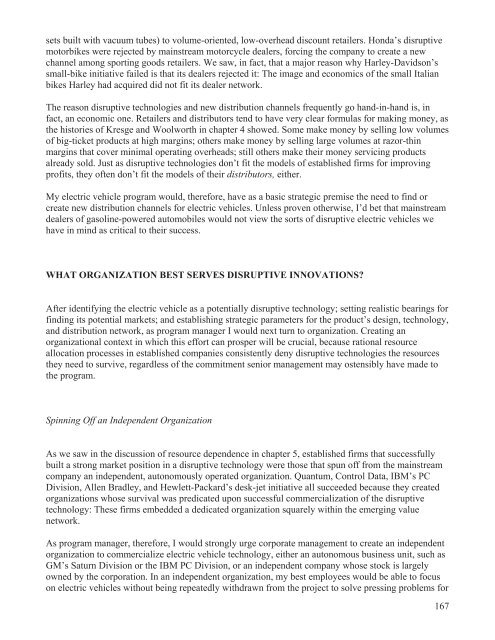PRUEBAS
PRUEBAS
PRUEBAS
Create successful ePaper yourself
Turn your PDF publications into a flip-book with our unique Google optimized e-Paper software.
sets built with vacuum tubes) to volume-oriented, low-overhead discount retailers. Honda’s disruptivemotorbikes were rejected by mainstream motorcycle dealers, forcing the company to create a newchannel among sporting goods retailers. We saw, in fact, that a major reason why Harley-Davidson’ssmall-bike initiative failed is that its dealers rejected it: The image and economics of the small Italianbikes Harley had acquired did not fit its dealer network.The reason disruptive technologies and new distribution channels frequently go hand-in-hand is, infact, an economic one. Retailers and distributors tend to have very clear formulas for making money, asthe histories of Kresge and Woolworth in chapter 4 showed. Some make money by selling low volumesof big-ticket products at high margins; others make money by selling large volumes at razor-thinmargins that cover minimal operating overheads; still others make their money servicing productsalready sold. Just as disruptive technologies don’t fit the models of established firms for improvingprofits, they often don’t fit the models of their distributors, either.My electric vehicle program would, therefore, have as a basic strategic premise the need to find orcreate new distribution channels for electric vehicles. Unless proven otherwise, I’d bet that mainstreamdealers of gasoline-powered automobiles would not view the sorts of disruptive electric vehicles wehave in mind as critical to their success.WHAT ORGANIZATION BEST SERVES DISRUPTIVE INNOVATIONS?After identifying the electric vehicle as a potentially disruptive technology; setting realistic bearings forfinding its potential markets; and establishing strategic parameters for the product’s design, technology,and distribution network, as program manager I would next turn to organization. Creating anorganizational context in which this effort can prosper will be crucial, because rational resourceallocation processes in established companies consistently deny disruptive technologies the resourcesthey need to survive, regardless of the commitment senior management may ostensibly have made tothe program.Spinning Off an Independent OrganizationAs we saw in the discussion of resource dependence in chapter 5, established firms that successfullybuilt a strong market position in a disruptive technology were those that spun off from the mainstreamcompany an independent, autonomously operated organization. Quantum, Control Data, IBM’s PCDivision, Allen Bradley, and Hewlett-Packard’s desk-jet initiative all succeeded because they createdorganizations whose survival was predicated upon successful commercialization of the disruptivetechnology: These firms embedded a dedicated organization squarely within the emerging valuenetwork.As program manager, therefore, I would strongly urge corporate management to create an independentorganization to commercialize electric vehicle technology, either an autonomous business unit, such asGM’s Saturn Division or the IBM PC Division, or an independent company whose stock is largelyowned by the corporation. In an independent organization, my best employees would be able to focuson electric vehicles without being repeatedly withdrawn from the project to solve pressing problems for167


